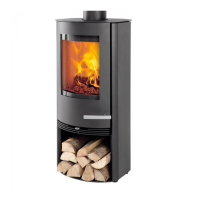10
Repairs of faults or replacement of parts on the product do not
extend the product or replacement part’s warranty period. Neither
does a new warranty period begin for the product or replaced part.
Apart from the above warranty rules, the consumer also has those
rights which are evident from the obligatory consumer legislation
Any fault or defect must be examined by the vendor who has sold
the product. In this case the purchaser must be able to prove that
the product has been purchased via the vendor and when it was
purchased, for example, in the form of an invoice/receipt. The
purchaser must specify the model and production number, which is
stated on the product. If the purchaser wishes to refer to a fault,
the vendor must be informed within a reasonable time, i.e. 14 days
after the defect has been ascertained.
HINTS
Lighting after long break
If the stove has not been used for a long time the chimney should
be checked for possible blockage before lighting. Furthermore it is
a good idea to remove any dust from the wood-burning stove as it
might smell after a long break.
Chimney re
In case of chimney re the doors, drawers and damper of the wood-
burning stove must be closed immediately in order to shut of the
supply of oxygen. The relevant authorities must be notied if neces-
sary. The stove must not be used until the chimney has been in-
spected.
Kindling is the designation for nely split wood/sticks that are
about 20 cm long and have a diameter of 2-3 cm.
Wood like birch, beech, oak, ash, elm, pine wood and wood from
fruit trees is all suitable for splitting into rewood.
Waste products like pressure-treated wood, chipboard, coloured
brochure or glossy paper must not be used in a wood-burning stove.
They develop hydrochloric acid or heavy metals which cause a lot of
damage to the stove and the environment.
Firewood should have a diameter of 7-9 cm and be no more than
about 30 cm long, otherwise it will get too close to the side of the
stove (at the CE-testing rewood at a length of 28 cm was used).
The most important thing for good combustion is that the wood is
dry (15-20% moisture). If the rewood is too wet it is difcult to get
it to burn, the chimney draught is nonexistent, there is a lot of smo-
ke and the exploitation is lower as the water has to evaporate rst.
Furthermore there may be damage to the stove and the chimney in
the shape of shining soot and tarry deposits. At worst it can cause a

